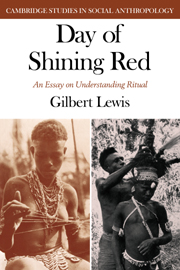Book contents
- Frontmatter
- Contents
- Analytical table of contents
- Preface
- 1 A question of interpretation
- 2 Problems of ritual in general
- 3 Views from one village
- 4 The rites of puberty seen
- 5 Rules of procedure and reflection on them
- 6 Silent forms but natural symbols?
- 7 Moon, river and other themes compared
- 8 For success in life
- 9 A choice of magic
- 10 Change and a rite falling into disuse
- 11 Inventory of themes
- References
- Index
- CAMBRIDGE STUDIES IN SOCIAL ANTHROPOLOGY
4 - The rites of puberty seen
Published online by Cambridge University Press: 30 October 2009
- Frontmatter
- Contents
- Analytical table of contents
- Preface
- 1 A question of interpretation
- 2 Problems of ritual in general
- 3 Views from one village
- 4 The rites of puberty seen
- 5 Rules of procedure and reflection on them
- 6 Silent forms but natural symbols?
- 7 Moon, river and other themes compared
- 8 For success in life
- 9 A choice of magic
- 10 Change and a rite falling into disuse
- 11 Inventory of themes
- References
- Index
- CAMBRIDGE STUDIES IN SOCIAL ANTHROPOLOGY
Summary
The village of Rauit sits at the end of a ridge among sharp-cut foothills and valleys on the inland side of the Torricelli mountain chain. It looks over forest south towards the Sepik river. Four of its hamlets are clumped in one main body at the last high point along the curling ridge. Another hamlet, Animbil, is close to them, but Bi'ip, the remaining one, is a quarter of an hour's walk through sago palms, a bit of forest, gardens, then along a branching ridge beside a cliff edge, away from the main part of the village. The houses of each hamlet are scattered close together higgledy-piggledy, the ground about them sandstone or mudstone with all grass and weeds scraped away. Coconut palms curve up high above the houses and ring right round the hamlets. Their feathery rustling crowns give shade in the village from the sun at noon. Surrounding the central area of bare brown ground and thatched brown houses are many shrubs, hibiscus, small groves of great green-leaved banana plants.
On an ordinary fine day, each hamlet will look deserted from about nine o'clock in the morning to about four in the afternoon. The doors of houses are shut and barred. The two or three grown-ups who have not gone off to the gardens will sit inconspicuous in the shade or under the roof of a day-house, minding babies or snoozing. But on a day when something special happens, the hamlet, not deserted and still seems very different.
- Type
- Chapter
- Information
- Day of Shining Red , pp. 73 - 88Publisher: Cambridge University PressPrint publication year: 1980

